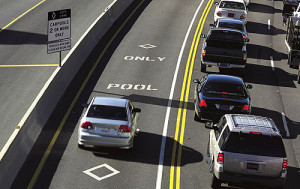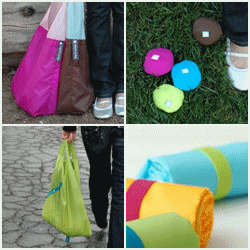We’re just as excited about Earth Day 2009 as you are, and we couldn’t ask for a better holiday. In fact, we thought the name should be changed to “Everyone Drop What You’re Doing, and Go Do Something Good for the Planet Day,” but that’s a little on the long side.
But when all the fun, games and tree plantings have come to an end after April 22, where does that leave you? What about the other 364 days of the year?
Simply put, Earth Day is essentially a reminder of what you should be doing year-round to reduce your environmental footprint. Recycling, reducing your consumption of goods, composting, using sustainable energy sources and taking public transportation are just a few of the actions you can take to, literally, make every day Earth Day.
We’re not the only ones who support the concept of Making Every Day Earth Day™. The Earth Day Network recently created a Green Generation Campaign with three core principles:
- Live carbon-free with renewable energy sources that decrease dependence on fossil fuels
- Consume responsibly and sustainably
- Create green jobs and a global green education system
We couldn’t agree more. So, in support of what others are doing to help spread this holiday out to a daily duty, here are our favorite eight ways to live a little more lightly on the planet:
1. Energy Vampires
In households across the U.S., phantom energy (energy used when items are plugged in but not in use) not only adds an additional 87 billion pounds of carbon dioxide into the atmosphere annually, but also costs homeowners $5.8 billion per year. Unplugging chargers and other electronics when the charge is complete, or when you’re simply done using them, can create up to 10 percent in energy savings. If devices are plugged into a power strip, just flip the switch and you’re done!

Using less water saves both energy and money. Photo: Gogreenblog.com
2. Every Drop Counts
Global climate change affects our water supply, and right now billions of people don’t have access to clean water. To conserve water here in the U.S., there are some easy steps you can take to reduce your consumption:
- Using one drinking glass or reusable bottle per day, rather than disposable plastic bottles
- Dumping ice or leftover water on plants instead of down the drain
- Turning the faucet off while brushing your teeth, shaving and soaping dishes
- Changing a washer’s settings to reflect the appropriate size load
3. Hazards of Outer Beauty
Each year people put on five pounds of personal care products, and they’re all absorbed by your skin. It’s important to know what you’re putting on your body and the environmental footprint of the products you purchase. Educate yourself on contents such as parabens and sulfates through the Cosmetic Safety Database and opt for greener products, such as those that use organic ingredients and recycled packaging.

Carpooling saves money on gas and reduces carbon emissions. Photo: campuscarpool.org.uk
4. Transportation: It’s All About Options
With enough cars on the road for every eligible American driver, there are numerous ways to help the environment when it comes to daily transportation. Cut back on vehicle emissions by carpooling, car sharing, riding public transportation and biking or walking to errands near home or the office.
If you must drive, increase fuel efficiency by consolidating trips, avoiding sudden starts or stops and removing unnecessary weight from your car. Not only will you save on carbon emissions, but you’ll save on the cost of operating your vehicle as well.
5. Choosy Consumers Choose Sustainable
Going to the store involves responsible choices: How food is grown, processed and transported is as equally important as picking the foods you eat.
- With organically grown food, herbicides and pesticides don’t enter the body or the soil
- Try not to eat red meat for a few days each week. Cows are responsible for 20 percent of U.S. emissions of methane, which traps 20 times more heat in the atmosphere than carbon dioxide
- Purchasing locally grown goods cuts down on environmental costs of transportation and helps your local economy
- If you have leftover produce, compost it to ensure that nothing goes to waste (jump to tip #8 for more info on composting)

Flip and Tumble bags are an easy way to reduce your usage of plastic bags. Photo: Boutiqueflair.com
6. It’s in the Bag
The average American uses an estimated 1,200 plastic bags per year. Bid single-use bags adieu and their negative environmental consequences. You may run into the “whoops, I left my bag in the car” a few times until you get into the habit of using them. In the meantime, we stumbled across Flip and Tumble bags that fit easily into your purse to help you remember. They roll up in seconds, and their bright colors make it hard to get lost at the bottom of your bag.
7. Paper Trail
Paper consumes more than one-third of landfill space, which in turn is detrimental to the environment because of methane creation. When it comes to paper, the three R’s are your key to success:
- Reduce: Request bills, statements, newsletters etc. to be sent electronically
- Reuse: Shred paper for packing materials or compost. Use old envelopes for scratch paper or notes, or save scraps for craft projects around the house.
- Recycle: Even those items like glossy junk mail, newspapers, cardboard boxes, magazines, phone books, etc. can be recycled.
8. Everyone Can Compost
According to the U.S. EPA, each American throws away an average of 1.3 pounds of food scraps daily. In addition to this, yard trimmings and food waste, combined, make up 24 percent of our nation’s municipal solid waste stream. If even half of this can be diverted and recycled through composting, our daily trash levels could start to decrease.
Composting increases gardening yields due to additional nutrient content in the soil. It also keeps moisture in the soil so you water less, and it binds to soil contaminants to keep them from spreading.
Whether you are in an urban environment or composting with worms, this home recycling option comes in many forms and can be easier than you may think.
Now Get Moving!
Even though these steps may seem simple enough, sometimes actually employing them in your everyday life can be more challenging than you think. But your small efforts really do add up to something bigger, such as increasing demand for green products and services, which also creates more green jobs.
In terms of global green education, spread the word to your friends or get involved in community events and organizations with a mission to live eco-responsibly.

Kasen Seaver
Kasen Seaver is a freelance writer for Earth911, and enjoys putting her knowledge of eco-conscious living into practice.